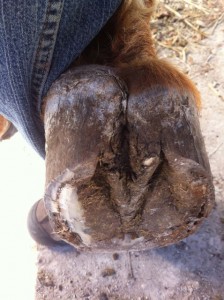 Your horse is lame and the vet says the problem is in the hoof but there is no reaction to hoof testers. If this is the case with your horse then you may want to consider a horse problem called sheer heel. When one side of the horse’s hoof grows faster than the other side the heel can be forced upwards on the fast growing side. This creates a sheering force between each side of the heel.
Your horse is lame and the vet says the problem is in the hoof but there is no reaction to hoof testers. If this is the case with your horse then you may want to consider a horse problem called sheer heel. When one side of the horse’s hoof grows faster than the other side the heel can be forced upwards on the fast growing side. This creates a sheering force between each side of the heel.
A horse problem like sheer heel can be hard to detect because there is rarely any heat or swelling around the heel and no reaction to pressure. The pain only occurs when the hoof strikes the ground and the internal structures are put under strain. Pain is often worse when the horse is moving in a tight circle on hard ground with the sore hoof on the inside of the circle. The horse will usually block sound with a nerve block at the level of the fetlock. Close inspection will reveal one heel and quarter area higher than the other. When each heel is grasped and pressure is applied in opposite directions the heels will move independently instead of resisting separation.
Horse Problems: Symptoms of sheer heel
Lameness in the hoof with no signs of heat, swelling or reaction to hoof testers
Lameness that is worse on a tight circle on hard ground with the affected leg to the inside
Lameness that blocks sound to a nerve block at the level of the fetlock
One heel and quarter area that is higher than the opposite side
Heels can be shifted up and down in opposite directions
Sheer heels occur when one side of the hoof grows faster than the other. Conformation of the leg can cause more pressure on one side of the hoof. Injuries or abscesses can create inflammation on one side of the hoof causing it to grow faster on that side. Sheer heel in less likely to occur in a barefoot horse because the ground will wear down the hooves evenly even if one side grows faster. A shoe will not wear down so the hoof on the faster growing side is forced upwards. Another advantage a barefoot horse can have is a better developed digital cushion which can resist sheering forces.
To correct a sheer heel you will have to remove the shoe for at least a period of time to allow the heel to settle back into normal position. When the weather is damp and the hooves are soft the hoof may settle in the time it takes for the farrier to shape a shoe. When the conditions are dry you may have to remove the shoe and keep the horse on soft ground until the longer heel drops back down where it can be trimmed level. In very dry conditions a hoof conditioner or poultice can be applied to the hoof to soften the wall so it will shift more quickly. It is sometimes necessary to trim the longer heel shorter so it will be encouraged to shift back down. Boots can be used on a barefoot horse for protection when the horse is not on soft ground.
Horse Problems: How to correct a sheer heel
Remove the shoe and allow the long heel to drop down so it can be trimmed before shoe is replaced
Keep the horse on soft ground so the heel can drop down
Soften the hoof wall to allow the heel to come down more quickly
Trim the heel and quarter area back to level often or even below level to encourage it to drop faster
A bad sheer heel can takes months to fully return to normal. Once the internal structures of the hoof are damaged they take time to heal. A wrap with draw solution will help take the soreness out of the hoof and encourage internal healing. Good nutrition with a whole food supplement such as blue green algae will help the hoof to grow more quickly. A barefoot horse is much less likely to develop a sheer heel so don’t use shoes at all unless you absolutely have to. If you must shoe your horse then watch the heels and quarters closely to make sure the hairline stays even.
Horse Problems: How to prevent a sheer heel
Good hoof nutrition
Keep you horse barefoot if possible
Watch the hairline at the quarters and heels to make sure it is level with the opposite side of the hoof
Horse problems like sheer heel can show up even with a good holistic horse care program. Paying attention to hoof quality and shape will help you avoid this frustrating condition. Madalyn
If you enjoyed this post or found it helpful, let me know by leaving a comment below. You can also find me on Facebook where I always appreciate a LIKE. To order any of the products mentioned in this post or other products for you or your horses, please visit my online store.